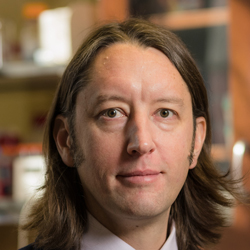Creating a Better RNA Switch
Newly developed switch activates genes thousands of times better than nature
If scientists could precisely regulate gene expression, they could turn off the genes responsible for illness and disease and turn on those that enhance health and the immune system.
“This is why controlling gene expression is so fundamental,” said Northwestern Engineering’s Julius Lucks. “Once you get a good handle on it, you can do anything.”
 For Lucks, having a “good” handle on gene expression might be an understatement. He and his team have developed a powerful and versatile tool that achieves gene activation thousands of times better than nature.
For Lucks, having a “good” handle on gene expression might be an understatement. He and his team have developed a powerful and versatile tool that achieves gene activation thousands of times better than nature.
“All we did was make an RNA switch that turns a gene on,” said Lucks, an associate professor of chemical and biological engineering in Northwestern’s McCormick School of Engineering. “But what really makes it awesome is that it’s really, really, really good.”
Supported by the National Science Foundation, the Defense Advanced Research Projects Agency, and the Searle Funds at the Chicago Community Trust, the research was published online on October 19 in the journal Nature Communications. James Chappell, a postdoctoral fellow in Lucks’s laboratory and now an assistant professor at Rice University, served as the paper’s first author.
Using a computational design approach, Lucks created the switch by molecularly programming an RNA molecule called called Small Transcription Activating RNA, or STAR that his group had previously discovered. He then uses an algorithm — developed by Northwestern alumnus Joe Zadeh (’03) — to optimize the STAR for specific applications. An outside company uses the algorithm’s results to construct a physical piece of RNA, which Lucks then uses in experiments.
Lucks likens STARs to a light switch.
“For anything to happen in biology, the ‘light’ has to be turn on,” said Lucks, a member of Northwestern’s Center for Synthetic Biology. “We’re always interested in turning things on, so we found a way to engineer some really good light switches.”
Continuing the analogy, the RNA switches found in nature are unable to turn the “lights” fully on or off. Often times the room is consistently dim instead of completely dark or brilliantly light. But researchers have desired to have a tighter control of the system. Lucks’ STAR can turn on the light — or activate a gene — 9,000 times brighter than without the STAR present, providing the completely dark or light room that researchers have lacked.
“If you study a system to explore what a gene does, you want to know what it does when it’s completely on or off,” Lucks explains. “Not when the gene is there or halfway there. That’s much harder to disentangle.”
That’s particularly true for diagnostic applications, which Lucks plans to pursue next with his new tool. Because RNA excels at detecting other strands of RNA, STARs could be useful in diagnosing RNA viruses. To do this, Lucks’ switch could be engineered to turn on in the presence of one of these viruses.
“You have to have super tight control to achieve this,” Lucks said. “You don’t want a halfway signal because then you will end up with false positives. You need a clear signal.”
Diagnostics, however, is just one thing that researchers can accomplish with STARs. Lucks is also interested in using them for metabolic engineering, regulating RNA networks, and more.
“This is an enabling technology, and we have collaborations starting right away,” Lucks said. “All of a sudden, all these different things are possible. And that’s just awesome.”